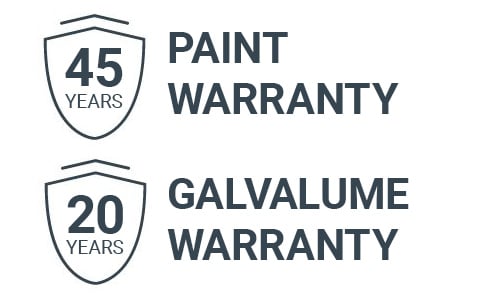
The Differences Between a Through-Fastened System and a Concealed Fastened System
Fortify Building Solutions offers both through-fastened and concealed-fastened roofing systems and we will take a look at the differences and benefits of each below.
Your Zip Code helps us provide the most accurate delivery information

Produced on-site at select locations as Perma-Lok or Advantage-Lok II panel.
Ideal for residential use, the Slimline® concealed fastener roof panels feature a modern and sleek profile, making them an excellent choice for those in search of a contemporary roofing solution.

Produced on-site at select locations as Perma-Lok or Advantage-Lok II panel.
Ideal for residential use, the Slimline® concealed fastener roof panels feature a modern and sleek profile, making them an excellent choice for those in search of a contemporary roofing solution.
Registered users sign in for your pricing.

When you need to order extra products or replacement materials, please be sure to order them from the same Fortify Building Solutions store location where you made your original purchase. This will ensure compatibility with the components you already have. Fortify Building Solutions cannot guarantee compatibility if additional products or replacement materials are not ordered from the same store where the original products were purchased.
Concealed Fastener System
16"
3:12
N/A
N/A
1"
Standard: 29
Optional: 26
Standard: Smooth
Optional: N/A
Standard: Minor Rib with Striations
Optional: Striations
Galvalume®, Galvalume Plus®, Signature® 200
Roof
1 year
There are several aspects of metal roofing that make it the most optimal solution for a new or existing build. Metal roofs are durable and offer a lengthy lifespan. Their low maintenance design can save money and time over the life of your roof a require minimal maintenance in comparison to traditional asphalt roofing.
There are three main metal roof types: Gable, Single-Slope, and Lean-to.
A Gable roof is defined by the triangular portion of the endwall from the level of the eave to the ridge of the roof and are the most common metal roof type. The benefits of metal gable roofs are that they easily shed water and snow as well as allow for more space, providing higher vaulted ceilings and better ventilation.
A single-slope roof type requires the sloping of one plane. The slope extends from one sidewall to the opposite sidewall. You often see these metal roof types on retail shopping centers as they are an aesthetically pleasing option.
A lean-to is more of an addition as opposed to a roof type however, lean-to’s are very distinctly identified and can have a common roof line if attached at the eave of the main building or a different pitch if connected at least 8” below eave.
Learn more about each roof slope in our article about the topic.
Yes. Metal roofing is a better value long term than selecting asphalt roofing. Metal roofing offers superior durability, often lasting 40-50 years longer than traditional shingle roofing. They are also exceptionally resistant to harsh weather conditions and require immensely less repairs and maintenance when properly installed and cared for.
There are three main factors to consider once you are ready to install your metal building. Accessibility, Storage, and Facilities.
Accessibility - Your metal building will be shipped to you on a flat-bed 18-wheeler, so the installation site will need to be accessible via road, or you will need to have an alternate plan to unload the building materials and get them to the site. Ensure your site offers plenty of clear space, free from debris, with enough room to stage components prior to installation.
Storage - To prevent damage to your metal building components, you will need a safe place for storage. Be sure to read the manufacturer’s instructions for storing materials.
Facilities - After ordering your building and choosing an erector, check with them to find out what they require for the jobsite. Some erectors require that the building owner provide a dumpster and latrines for the site.
Learn more about how to prepare your site for installation.
Thats a great question. We believe, unequivocally, that what sets Fortify apart from others in the market are our standards.
We are affiliated with several independent organizations, such as the International Accreditation Service (IAS), the Metal Building Manufacturers Association (MBMA), and the Better Business Bureau (BBB), that review our standards and practices on a regular basis and issue their respective approval based on their findings. We are, and have always been, in good standing with these organizations.
In addition, we have several internal checks and balances in place to ensure that your steel building is not only an extremely good value, but that it will also meet the specified codes and loads requirements of your particular locality.
Read more about what makes us a leader in the metal building and roofing market.

Fortify Building Solutions offers both through-fastened and concealed-fastened roofing systems and we will take a look at the differences and benefits of each below.

Your metal roof is engineered to offer years of protection with minimal upkeep, however, to maintain your roof’s optimal performance, it is recommended to establish a regular maintenance program.

Metal building terminology can be confusing if you are not accustomed to the language day in and day out. Let’s talk about the differences with purlins, girts and eave struts so you can make better sense of what is what on your metal building.

In this article, we will take a look at various roof types and describe the different roof slopes so you can make an informed decision on what works best for your project.
Share